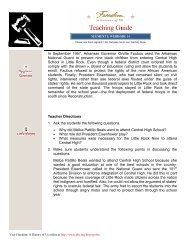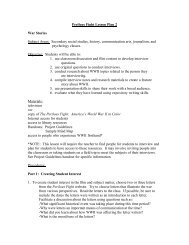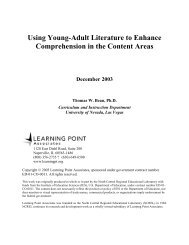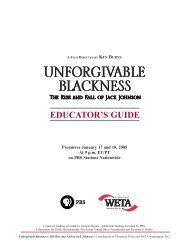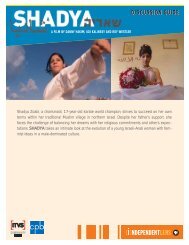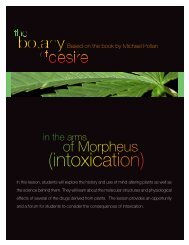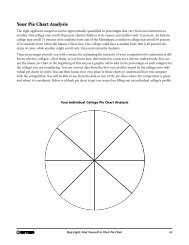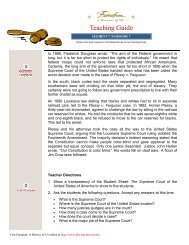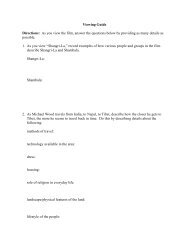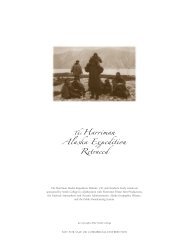from swastika to jim crow discussion guide - PBS
from swastika to jim crow discussion guide - PBS
from swastika to jim crow discussion guide - PBS
Create successful ePaper yourself
Turn your PDF publications into a flip-book with our unique Google optimized e-Paper software.
From<br />
Swastika <strong>to</strong><br />
Jim Crow<br />
Discussion Guide
Howard P. Berkowitz, National Chair<br />
Abraham H. Foxman, National Direc<strong>to</strong>r<br />
Glen A. Tobias, Chair, National Executive Direc<strong>to</strong>r<br />
Peter T. Willner, Associate National Direc<strong>to</strong>r<br />
Direc<strong>to</strong>r, Development Division<br />
Kenneth Jacobson, Assistant National Direc<strong>to</strong>r<br />
Direc<strong>to</strong>r, International Affairs Division<br />
Cynthia Marks, Chair, Education Division Committee<br />
Judi Krupp, Vice Chair, Education Division Committee<br />
Chair, A WORLD OF DIFFERENCE ® Institute<br />
Caryl Stern-LaRosa, Direc<strong>to</strong>r, Education Division<br />
Ed Alster, Assistant Direc<strong>to</strong>r, Education Division<br />
This resource <strong>guide</strong> was prepared by the Education Division.<br />
© 2000 Anti-Defamation League<br />
823 United Nations Plaza, New York, NY 10017<br />
(212) 885-7700/885-7800 Fax: (212) 867-0779/490-0187<br />
www.adl.org<br />
Printed in the United States of America<br />
All Rights Reserved<br />
No part of this book may be reproduced or utilized in any form or by any means, electronic or mechanical,<br />
including pho<strong>to</strong>copying and recording, or by an information s<strong>to</strong>rage and retrieval system, without permission<br />
in writing <strong>from</strong> the publisher.<br />
For more information about ITVS, contact us at 51 Federal Street, First Floor, San Francisco, CA 94107;<br />
(415) 356-8383; FAX (415) 356-8391; itvs@itvs.org. Material <strong>from</strong> this <strong>guide</strong> and information about airdates<br />
is available on the ITVS Web site, www.itvs.org.
FROM SWASTIKA TO JIM CROW<br />
DISCUSSION GUIDE<br />
INTRODUCTION<br />
Based on a book by the late Gabrielle Simon Edgcomb, the film From Swastika <strong>to</strong> Jim Crow<br />
tells the little-known s<strong>to</strong>ry of two different cultures that share elements of a common burden<br />
of oppression. Jewish refugee scholars who fled Nazi Germany and arrived in the United<br />
States were often excluded <strong>from</strong> mainstream American universities due <strong>to</strong> anti-Semitism and<br />
anti-foreigner sentiment. Some found employment in an unusual place – Black colleges in<br />
the segregated South.<br />
Through interviews and anecdotes, viewers learn how two very different peoples adapted and<br />
even flourished in difficult and harsh circumstances. While it specifically focuses on Black-<br />
Jewish relations, From Swastika <strong>to</strong> Jim Crow provides an opportunity for dialogue for all people<br />
who seek ways of fighting injustice and securing dignity for all. This <strong>discussion</strong> <strong>guide</strong> was<br />
designed with that goal in mind. It is our hope that this film will be used as a springboard<br />
for dialogue in communities where racial tensions have existed, in places where people are<br />
unaware of this unique chapter of American his<strong>to</strong>ry and in communities that work <strong>to</strong> maintain<br />
communication and dialogue among their diverse members.<br />
A NOTE TO DISCUSSION LEADERS<br />
Discussion leaders will be leading a <strong>discussion</strong> for community members who have all viewed<br />
the film From Swastika <strong>to</strong> Jim Crow. The <strong>discussion</strong> leader should consider the following recommendations:<br />
1 Preview the film and read the <strong>discussion</strong> <strong>guide</strong> prior <strong>to</strong> the program.<br />
2 In most situations you will have three hours for the program which will include both<br />
the viewing of From Swastika <strong>to</strong> Jim Crow (1 hour), as well as the <strong>discussion</strong>. Plan <strong>to</strong><br />
provide introduc<strong>to</strong>ry remarks (20 minutes) as well as time for thoughtful <strong>discussion</strong><br />
and dialogue after the film (1 1/2 hours).<br />
1
3 In some situations participants may feel more comfortable speaking in a smaller<br />
group. You may want <strong>to</strong> divide the audience in<strong>to</strong> groups of three or four and have<br />
them discuss certain issues that may prove more sensitive before having them discuss<br />
them as a full group. This will enable more people <strong>to</strong> participate comfortably in the<br />
<strong>discussion</strong>.<br />
4 Suggested Discussion Guidelines should be shared with the participants during your<br />
introduction. Discussion leaders should understand that participants will bring different<br />
experiences <strong>to</strong> the program. Therefore, it is important <strong>to</strong> create an environment<br />
that is open and safe for all <strong>to</strong> share their viewpoints, experiences, insights and<br />
ideas.<br />
Suggested Ground Rules:<br />
a Mutual respect is very important. Participants should be respectful of one another’s<br />
opinions and assume responsibility for their own learning.<br />
b Everyone is encouraged <strong>to</strong> actively participate in the <strong>discussion</strong>, but only one at a<br />
time.<br />
c Participants should be open <strong>to</strong> new ideas and <strong>to</strong> each other. Request that participants<br />
use statements that signify that they are talking only about and for themselves.<br />
d The <strong>to</strong>pics for <strong>discussion</strong> that the film will elicit may be more difficult for some<br />
people <strong>to</strong> talk about than others. Participants should be sensitive <strong>to</strong> each other’s<br />
needs and privacy, including confidentiality.<br />
BACKGROUND<br />
In January of 1933, Adolf Hitler and his Nazi Party legally and democratically rose <strong>to</strong> power<br />
in Germany. Almost immediately, Hitler began a systematic campaign of oppression and terror<br />
against Jews, who up until that point had been an integral part of German culture, commerce,<br />
and education. Jewish businesses were boycotted on April 1, 1933, but following an<br />
international outcry that boycott was limited <strong>to</strong> one day. Soon after, Hitler placed economic<br />
sanctions on Jews and limited their right <strong>to</strong> practice their trades. On April 25, 1933, the Law<br />
for Preventing Over<strong>crow</strong>ding in German Schools and Schools of Higher Education <strong>to</strong>ok<br />
effect. This law restricted enrollment of Jews and soon thereafter Jewish professors began <strong>to</strong><br />
be dismissed <strong>from</strong> universities. While few, if any, could imagine that by 1941 the Germans<br />
would begin the systematic slaughter of Jews – a slaughter that over the next four years would<br />
take the lives of close <strong>to</strong> six million souls – many of these scholars realized in the early 1930s<br />
2
that Jews had no future in Germany and fled <strong>to</strong> the United States. Most of the 1,200 refugee<br />
scholars who arrived in this country could not find work in their fields. A small number,<br />
however, would end up in the his<strong>to</strong>rically Black colleges of the American South.<br />
In many ways, these scholars discovered that the American South was not unlike Germany in<br />
the mid 1930s before mass murder became the policy of the German state. Southern Blacks<br />
lived under the oppression of the Jim Crow laws, which legislated the strict segregation of<br />
Blacks <strong>from</strong> Whites. Forbidden <strong>from</strong> attending the same schools, eating in the same restaurants,<br />
playing in the same parks, Blacks were considered second-class citizens.<br />
The his<strong>to</strong>rically Black private colleges represented a rare opportunity for educational advancement<br />
and were havens for aspiring young Blacks. Exempt <strong>from</strong> local segregation laws, they<br />
were one of the few places where Blacks could freely associate with Whites without being<br />
arrested under the myriad of ordinances enforcing segregation. Many of these colleges needed<br />
qualified teachers and saw in these refugees prominent scholars <strong>to</strong> attract <strong>to</strong> their campuses,<br />
and who, having fled oppression themselves, might have special sensitivity <strong>to</strong> the experience<br />
of the Black students they would teach. For the scholars, employment at the Black colleges<br />
offered an invaluable opportunity <strong>to</strong> continue their professional work at a time when<br />
work in their fields was scarce.<br />
Fifty-one refugee scholars would end up taking positions in 19 different institutions.<br />
Shunned by the White community for being both Jewish and foreign, unable <strong>to</strong> fully integrate<br />
with the Black community due <strong>to</strong> segregation laws, the experience of the refugee scholars<br />
would prove <strong>to</strong> be very difficult but, in many cases, very rewarding.<br />
As Gabrielle Edgcomb writes in her book, From Swastika <strong>to</strong> Jim Crow, “The significance of<br />
this his<strong>to</strong>rical episode lies in the encounter between two diverse groups of people, both victims<br />
of extreme manifestations of racist oppression and persecution, albeit under vastly different<br />
his<strong>to</strong>rical conditions. The Europeans came out of a middle class intellectual environment…<br />
African Americans at the time were two and three generations removed <strong>from</strong> slavery,<br />
under which even learning <strong>to</strong> read had been generally forbidden.”<br />
This film is the s<strong>to</strong>ry of that his<strong>to</strong>ric encounter.<br />
3
COMMON LANGUAGE/VOCABULARY<br />
Stereotype, Prejudice, Discrimination, Racism, Refugee, Anti-Semitism, Religious Bigotry,<br />
Segregation, Tenure, Jim Crow laws, Holocaust, and Black Power<br />
THE SCHOLARS<br />
The following scholars are highlighted in the film:<br />
ERNST MANASSE<br />
Professor of German, Latin and Philosophy<br />
North Carolina Central University (previously<br />
known as North Carolina College for<br />
Negroes)<br />
Durham, North Carolina<br />
1939 – 1973<br />
LORE RASMUSSEN<br />
Elementary Education instruc<strong>to</strong>r<br />
Talledega College<br />
Talladega, Alabama<br />
1949 – 1955<br />
JOHN HERZ<br />
Professor of Political Science<br />
Howard University<br />
Washing<strong>to</strong>n, D.C.<br />
1941 – 1943, 1948 – 1952<br />
VIKTOR LOWENFELD<br />
Professor of Art<br />
Hamp<strong>to</strong>n Institute<br />
Hamp<strong>to</strong>n, Virginia<br />
1939 – 1946<br />
FRITZ PAPPENHEIM<br />
Professor of German and Economics<br />
Talladega College<br />
Talladega, Alabama<br />
1944 – 1952<br />
ERNST BORINSKI<br />
Professor of Sociology, German and Russian<br />
Tougaloo College<br />
Tougaloo, Mississippi<br />
1947 – 1983<br />
4
THEMES<br />
The primary theme in From Swastika <strong>to</strong> Jim Crow is the development and impact of the relationship<br />
between the German-Jewish refugee scholars and their Black students and colleagues.<br />
These two diverse peoples, both victims of mutual racial terror and oppression, managed <strong>to</strong><br />
survive and attain a certain amount of success despite their circumstances. During the course<br />
of the film, three basic themes emerge:<br />
A Discrimination and Racism in Nazi Germany and the United States<br />
B The Relationship Between Blacks and Jews<br />
C Fighting Racism<br />
DISCRIMINATION AND RASCISM IN NAZI GERMANY AND<br />
THE UNITED STATES<br />
The German-Jewish refugees who came <strong>to</strong> the American South in the 1930s and 1940s were<br />
in many ways condemned <strong>to</strong> a “double exile” experience. Many arrived in New York, having<br />
left everything they had known, under the most difficult experience of persecution <strong>to</strong> find<br />
anti-Semitism and an anti-foreigner sentiment quite prevalent in American society. They<br />
then left the Northeast, where refugee resources existed, <strong>to</strong> look for job security at Black colleges<br />
in the South. Upon arrival, they soon realized that their life would now be a balancing<br />
act where they would have <strong>to</strong> live in a White community that did not welcome them, while<br />
working in the Black community. For many of these refugee scholars, it was their intellectual<br />
skill and personal integrity that enabled them <strong>to</strong> survive in this difficult situation. The<br />
irony of their own situation in Nazi Germany, and what they encountered in the American<br />
South of the 1930s and ’40s, was not lost on these scholars.<br />
The students and faculty who attended and worked at the Black colleges and universities<br />
experienced a unique sense of freedom. Black colleges were exempt <strong>from</strong> Jim Crow laws.<br />
Because there were none of the restrictions that were common in the general community, the<br />
staff was often integrated and an atmosphere of mutual respect between the students and the<br />
faculty was fostered. The colleges provided opportunities for Black youth <strong>to</strong> receive higher<br />
education in a segregated society at a time when rural, Southern Blacks were denied equal K-<br />
12 educational opportunities. While these campuses often provided a “safe haven” where civilized<br />
discourse was encouraged and nurtured, off–campus students were still required <strong>to</strong><br />
abide by the segregation laws of the United States.<br />
5
RELATIONSHIP BETWEEN BLACKS AND JEWS<br />
As depicted in the film, many close relationships developed between the refugee scholars and<br />
their students. Several anecdotes reveal how the scholars saw the obvious potential of many<br />
of their students and encouraged them <strong>to</strong> strive <strong>to</strong>wards higher learning and <strong>to</strong> seek further<br />
opportunities. A unique relationship developed between these two groups. For both, it was<br />
the understanding that they had a shared his<strong>to</strong>ry of persecution, which they believed resulted<br />
in a shared value system. In some cases, the scholars welcomed the chance <strong>to</strong> teach Black<br />
students, since they wanted, as Vik<strong>to</strong>r Lowenfeld stated, “<strong>to</strong> cast their lots with those people<br />
who were fighting racism.” John Herz recounts in the film, “that he assumed that his Black<br />
students would have more interest and a better understanding in Fascism, Nazism and<br />
Racism.” Given the experiences of the Black students, he thought that it would be relatively<br />
easy <strong>to</strong> teach them these philosophies.<br />
There was also the belief among some students that since the scholars had experienced such<br />
cruelty in Europe, they would be more empathetic <strong>to</strong> their plight and vice versa. Black students<br />
were often more trusting of their Jewish professors, as they were not seen as completely<br />
White. It was often the case that the students and the White community saw these refugees<br />
as “some kind of colored folk.”<br />
FIGHTING RACISM<br />
Finally, many of the professors saw that working at the Black colleges provided them with a<br />
unique opportunity <strong>to</strong> lend their voice <strong>to</strong> a growing chorus demanding civil rights in the<br />
United States. In some cases, because of their unusual role on campus, the scholars were able<br />
<strong>to</strong> bring the campus community and the general community (which was often White) <strong>to</strong>gether<br />
<strong>to</strong> share ideas and <strong>to</strong> challenge the system. In one case – the denial of Fritz Pappenheim’s<br />
tenure at Talladega College – the students were inspired <strong>to</strong> protest by his actions and moral<br />
convictions.<br />
In the late 1960’s, the Black Power Movement grew out of the Civil Rights Movement. The<br />
Black Power Movement espoused self-defense tactics, self-determination, political and economic<br />
power, and racial pride. It was a controversial split <strong>from</strong> Dr. Martin Luther King’s ideology<br />
of nonviolence and racial integration. It was seen by moderate Blacks as detrimental <strong>to</strong><br />
the civil rights cause and was viewed with apprehension by many Whites. While the Black<br />
Power Movement proved <strong>to</strong> be a difficult time for these refugee scholars, many remained<br />
committed <strong>to</strong> promoting integration and fighting racism and thus stayed at their institutions.<br />
6
DISCUSSION QUESTIONS<br />
The following <strong>discussion</strong> questions have all been categorized by the specific themes, as noted.<br />
Discussion leaders may want <strong>to</strong> ask the questions in the order listed below or thematically.<br />
1 Discuss and contrast the ways in which Jews were discriminated against and oppressed<br />
in Nazi Germany with how Blacks were discriminated against and oppressed in the<br />
American South of the 1930s and 1940s. (DISCRIMNATION/RACISM)<br />
2 In the book From Swastika <strong>to</strong> Jim Crow, the President of Fisk University writes in a<br />
letter, “We do not recommend the placement of refugees in [Black Colleges] because<br />
of the double handicap it places them under.” What do you think he means by “double<br />
handicap?” How were the German-Jewish scholars able <strong>to</strong> balance their role of<br />
working in the Black community with living in an often hostile White community?<br />
How were the students able <strong>to</strong> balance their lives of relative freedom at the Black colleges<br />
as opposed <strong>to</strong> their restricted life of segregation and discrimination? (DISCRIMI-<br />
NATION/RACISM)<br />
3 Ernst Manasse said, “I came <strong>from</strong> a situation of forced segregation (in Germany)<br />
where we were victims and now suddenly I was on the other side. I belonged not <strong>to</strong><br />
the oppressed, but <strong>to</strong> the oppressor. And that was very, very uncomfortable for me.”<br />
How did he (and the other scholars) deal with this situation? Were they effective?<br />
Describe similar situations <strong>to</strong> this dynamic that may exist <strong>to</strong>day? What are they?<br />
Discuss what you would do if you were placed in a similar situation? (DISCRIMINA-<br />
TION/RACISM)<br />
4 What fac<strong>to</strong>rs existed in America of the 1930s and ’40s that allowed racism and segregation<br />
<strong>to</strong> flourish? Why do you think the racial policies in America were not condemned?<br />
What fac<strong>to</strong>rs exist <strong>to</strong>day that allow racism <strong>to</strong> continue? Have these fac<strong>to</strong>rs<br />
changed <strong>from</strong> the ones that existed in the 1930s and ’40s?<br />
(DISCRIMINATION/RACISM)<br />
5 What do you think these refugee scholars thought when they saw a “White Only”<br />
water fountain or restaurant, or saw a Black person relegated <strong>to</strong> the back of a bus?<br />
How might they have responded? What would you do if you were placed in a similar<br />
situation? How would you respond? (DISCRIMINATION/RACISM – FIGHTING RACISM)<br />
7
6 In Nazi Germany, the Nuremburg laws of 1935 formally defined a Jew based upon<br />
the religion of their grandparents. In the South, anyone of ascertainable or strongly<br />
suspected Black ancestry was considered a “person of color” according <strong>to</strong> the Jim<br />
Crow laws. What do you think are the ramifications of defining people, not by their<br />
actions or beliefs, but by their race? (DISCRIMINATION/RACISM)<br />
7 Lore Rasmussen speaks of an occasion when she and her husband ate in a Black<br />
restaurant and were promptly arrested for “violating sanitary codes, interrogated, and<br />
accused of being German spies.” The arresting officers wondered “how they<br />
(Rasmussen and her husband) got that way.” What did they mean by that? What<br />
makes some people feel ready <strong>to</strong> fight injustice whenever it rears it head and what<br />
keeps others <strong>from</strong> responding? Is it possible that not acting is a response <strong>to</strong> fighting<br />
racism? Explain. (DISCRIMINATION/RACISM – FIGHTING RACISM)<br />
8 In the above situation with the Rasmussens, when law enforcement officials found out<br />
she was a refugee who had escaped Nazi Germany, she was <strong>to</strong>ld, “You should be glad<br />
<strong>to</strong> be in a place where there is democracy and freedom.” Comment on the irony of<br />
that statement. (DISCRIMINATION/RACISM)<br />
9 Why do you suspect their Black students often saw the refugee scholars as “men<strong>to</strong>rs”?<br />
What kinds of lessons do you think the scholars learned <strong>from</strong> their students? With the<br />
emergence of the Black Power movement in the late 1960s, was this relationship still<br />
possible? Can this dynamic still exist <strong>to</strong>day? Explain. (BLACKS AND JEWS)<br />
10 One of the reasons why Germans forced the Jews <strong>to</strong> wear yellow stars was because<br />
their identity was not apparent. Both Jews and Blacks had a common word for this<br />
phenomenon, “passing” – the Jew as non-Jew, the Black as White. What else do you<br />
think the refugee scholars shared in common with their students that may not have<br />
been articulated in the film? (BLACKS AND JEWS)<br />
11 Donald Cunnigen relates in the film how several of his friends thought Jews, by the<br />
virtue of their long his<strong>to</strong>ry of being oppressed, were Black. Oftentimes, the White<br />
community also did not see the Jews as completely White. How do you think the climate<br />
has changed for both Jews and Blacks since the the 1930s and 40s? What did<br />
Blacks and Jews have in common during the time depicted in the film? Explain<br />
whether or not these commonalities still exist <strong>to</strong>day. (BLACKS AND JEWS)<br />
8
12 Ernst Borinski would organize evenings in which Blacks and Whites would have <strong>to</strong> sit<br />
next <strong>to</strong> each other for dinner. This was revolutionary in the segregated South. How<br />
have you felt in situations where you spent time with people whose appearance, way<br />
of life, or religion was very different <strong>from</strong> yours? How did these people differ or meet<br />
your expectations? Do you believe that providing opportunities for people who are<br />
considered “different <strong>from</strong> each other” <strong>to</strong> interact has a role in race relations <strong>to</strong>day?<br />
How has this role changed since the time depicted in the film? (FIGHTING RACISM)<br />
13 Ernst Manasse designed and taught a class entitled “The Black Problem,” during the<br />
late 1960s. It was attended by both students and faculty and initially fostered much<br />
discourse and dialogue. But as time went on, he was asked <strong>to</strong> no longer teach this<br />
course because of his perspective as a White man. Have you ever had a teacher who<br />
taught about a subject that they were not directly a part of? Were they able <strong>to</strong> teach<br />
effectively? Have you ever had a teacher who was part of an experience and could not<br />
teach effectively? Is it possible for non-Gays <strong>to</strong> teach Gay literature or for men <strong>to</strong><br />
teach Women’s Studies? How do we understand an experience that is not our own?<br />
(FIGHTING RACISM)<br />
14 For some, their understanding of the Black Power Movement was the idea that Blacks<br />
should only identify with Blacks. What do you think of this? What are the pros and<br />
cons of the members of a group segregating themselves <strong>from</strong> other members of their<br />
community? How was the experience of these professors and their students antithetical<br />
<strong>to</strong> that idea? (FIGHTING RACISM)<br />
15 What do you believe <strong>to</strong> be the lasting lessons of the s<strong>to</strong>ry depicted in From Swastika<br />
<strong>to</strong> Jim Crow? Has your understanding of the relationship between Blacks and Jews<br />
changed as a result of viewing this film? How can we bring the message of the film<br />
<strong>to</strong> the larger community <strong>to</strong> encourage dialogue and action amongst its members?<br />
(FIGHTING RACISM)<br />
9
BIBLIOGRAPHY OF RESOURCES AND ORGANIZATIONS<br />
Selected Bibliography on the Black and Jewish Relationship<br />
Baldwin, J. (1967, April 9). “Negroes are Anti-Semitic Because They are Anti-White.” New<br />
York Times Magazine.<br />
Berman, Paul (1994). Blacks and Jews: Alliances and Arguments, ed. Paul Berman. New York:<br />
Delacorte.<br />
Bobo, L. (1988). “Group conflict, prejudice, and the paradox of contemporary racial attitudes.”<br />
In P. A. Katz & D. A. Taylor (Eds.), Eliminating Racism: Profiles in Controversy<br />
(pp. 85-114). New York: Plenum Press.<br />
Cherry, R. (1990). “Middleman minority theories: Their implication for Black-Jewish relations.”<br />
Journal of Ethnic Studies, 17, 117-138.<br />
Friedman, Murray (1995). What Went Wrong? The Creation and Collapse of the Black-Jewish<br />
Alliance. New York: Free Press.<br />
Gates, Henry Louis (1994). “The Uses of Anti-Semitism.” In Blacks and Jews: Alliances and<br />
Arguments, ed. Paul Berman, pp. 217-228. New York: Delacorte.<br />
Hacker, Andrew (1992). Two Nations: Black and White Separate, Hostile and Unequal.<br />
New York: Charles Scribner’s Sons.<br />
Jolkovsky, Binyamin (1997). “Want a Quote?” Forward, February 14, pp. 1,12.<br />
Kaufman, J. (1988). Broken Alliance: The Turbulent Times Between Blacks and Jews in America.<br />
New York: Charles Scribners Sons.<br />
Laurence, T. (1988). Jews, Blacks, and Group Au<strong>to</strong>nomy. Social Theory and Practice, 14, 55-<br />
69.<br />
10
Lerner, Michael and Cornel West (1995). Jews and Blacks: Let the Healing Begin. New York:<br />
G. P. Putnam’s Sons.<br />
Locke, Hubert (1994). The Black Anti-Semitism Controversy: Protestant Views and Perspectives.<br />
Selingsgrove, PA: Susquehanna University.<br />
Pogrebin, Letty Cottin (1992). “Blacks and Jews: Different Kinds of Survival.” In Bridges and<br />
Boundaries: African Americans and American Jews, ed. Jack Salzman, Adina Back, and<br />
Gretchen Sorin, pp. 132-135. New York: George Braziller.<br />
Rubin, Gary (1995). “How Should We Think About Black Antisemitism?” In Antisemitism in<br />
America Today: Outspoken Experts Explode the Myths, ed. Jerome Chanes, pp. 150-170.<br />
New York: Carol Publishing Group.<br />
Selected Bibliography on the time period depicted in the film<br />
Berenbaum, Michael. The World Must Know. Little, Brown and Company, 1993.<br />
Boyers, Robert, ed. The Legacy of the German Refugee Intellectuals. Schocken<br />
Books, 1972.<br />
Bullock, Henry Allen. A His<strong>to</strong>ry of Negro Education in the South. Harvard<br />
University Press, 1967.<br />
Diner, Hasia. In the Almost Promised Land: American Jews and Blacks, 1915-1935.<br />
Baltimore, Md.: Johns Hopkins University Press, 1995 edition.<br />
Edgcomb, Gabrielle Simon. From Swastika <strong>to</strong> Jim Crow. Krieger Publishing<br />
Company, 1993.<br />
Franklin, John Hope and Alfred A. Moss, Jr., From Slavery <strong>to</strong> Freedom: A<br />
His<strong>to</strong>ry of African Americans. 8th Edition. New York: McGraw-Hill, 2000.<br />
Myrdal, Gunnar. An American Dilemma: The Negro Problem and Modern Democracy.<br />
New York: Harper and Brothers publishers, 1944. (1990s editions).<br />
11
Selected Organizations:<br />
Amistad Research Center<br />
arc@mailhost.tcs.tulane.edu<br />
504-865-5535<br />
Til<strong>to</strong>n Hall<br />
Tulane University<br />
New Orleans, LA 70118-5698<br />
Anti-Defamation League<br />
www.adl.org<br />
212-490-2525<br />
823 United Nations Plaza<br />
New York, NY 10017<br />
Hillel: The Foundation for Jewish Campus<br />
Life<br />
www.hillel.org<br />
202-857-6560<br />
1640 Rhode Island Avenue NW<br />
Washing<strong>to</strong>n, DC 20036<br />
Moorland Spinarn Research Center<br />
500 Howard Place<br />
Howard University<br />
Washing<strong>to</strong>n, DC 20059<br />
National Association for the Advancement<br />
of Colored People<br />
www.naacp.org<br />
410-521-4939<br />
4805 Mt. Hope Drive<br />
Baltimore, MD 21215<br />
National Urban League<br />
www.nul.org<br />
212-558-5300<br />
120 Wall Street<br />
New York, NY 10005<br />
Operation Understanding<br />
117 S. 17 th Street, Ste 1010<br />
Philadelphia, PA 19103<br />
215-665-2300<br />
The Schomberg Center for Research<br />
www.nypl.org/research/sc/sc.html<br />
515 Malcolm X Blvd.<br />
New York, NY 10037-1801<br />
212-491-2200<br />
Southern Christian Leadership<br />
Conference<br />
www.mindspring.com/~sar<strong>to</strong>r/gradyhs/<br />
org_SCLC.html<br />
404-522-1420<br />
334 Auburn Ave NE<br />
Atlanta, GA 30312<br />
United States Holocaust Memorial<br />
Museum<br />
www.ushmm.org<br />
202-488-0400<br />
100 Raoul Wallenberg Place SW<br />
Washing<strong>to</strong>n, DC 20024-2156<br />
12
A special thanks <strong>to</strong> Hallie Esbin Rosen for her efforts <strong>to</strong> assure the success of this project.<br />
Additional thanks <strong>to</strong> the following people who shared their wisdom and expertise in the<br />
preparation of this <strong>discussion</strong> <strong>guide</strong>.<br />
Dr. Russell Adams, Howard University<br />
Dr. Michael Berenbaum, The Berenbaum Group<br />
Pamela Calvert, ITVS<br />
Christian Dorsey, Operation Understanding<br />
Karen Feinberg, Leland Johnson Common Vision Program<br />
David Fribush, The Berenbaum Group<br />
Rabbi Brant Rosen<br />
FROM SWASTIKA TO JIM CROW was directed by Lori Cheatle and Martin D. Toub and<br />
produced by Lori Cheatle, Steven Fischler and Joel Sucher in association with the<br />
Independent Television Service (ITVS), with funding provided by the Corporation for Public<br />
Broadcasting.<br />
13
Anti-Defamation League of B’nai B’rith<br />
NATIONAL OFFICE (webmaster@adl.org)<br />
823 United Nations Plaza, New York, NY 10017 ................................................................................................................................(212) 885-7700<br />
WASHINGTON OFFICE<br />
1100 Connecticut Avenue, NW (Suite 1020), Washing<strong>to</strong>n, DC 20036 (natlgov@adl.org) ................................................................(202) 452-8320<br />
REGIONAL OFFICES<br />
ALBUQUERQUE<br />
P.O. Box 21639, Albuquerque, NM 87154 (new-mexico@adl.org) ....................................................................................................(505) 823-2712<br />
ARIZONA<br />
The First Interstate Tower, 3550 North Central Avenue (Suite 914),<br />
Phoenix, AZ 85012 (arizona@adl.org) ................................................................................................................................................(602) 274-0991<br />
ATLANTA (Southeast)<br />
One Securities Centre, 3490 Piedmont Road NE (Suite 610), Atlanta, GA 30305 (atlanta@adl.org) ...............................................(404) 262-3470<br />
BOSTON (New England)<br />
126 High Street, 4th Floor, Bos<strong>to</strong>n, MA 02110 (bos<strong>to</strong>n@adl.org) .....................................................................................................(617) 457-8800<br />
CHICAGO (Greater Chicago/Upper Midwest)<br />
309 West Washing<strong>to</strong>n (Suite 750), Chicago, IL 60606 (chicago@adl.org) ..........................................................................................(312) 782-5080<br />
CLEVELAND (Ohio/Kentucky/Allegheny)<br />
505 Terminal Tower, Cleveland, OH 44113 (cleveland@adl.org) .......................................................................................................(216) 579-9600<br />
CONNECTICUT<br />
345 Whitney Avenue, New Haven, CT 06511 (connecticut@adl.org) ..............................................................................................(203) 772-1300<br />
DALLAS (North Texas/Oklahoma)<br />
12800 Hillcrest Road (Suite 219), Dallas, TX 75230 (dallas@adl.org) ..............................................................................................(972) 960-0342<br />
DC (District of Columbia/Maryland/Virginia/North Carolina)<br />
1100 Connecticut Avenue, NW (Suite 1020), Washing<strong>to</strong>n, DC 20036 (washing<strong>to</strong>n-dc@adl.org) ....................................................(202) 452-8310<br />
DENVER (Mountain States)<br />
1120 Lincoln Street (Suite 1301), Denver, CO 80203-2136 (denver@adl.org) ..................................................................................(303) 830-7177<br />
DETROIT (Michigan)<br />
4000 Town Center (Suite 420), Southfield, MI 48075-1402 (detroit@adl.org) .................................................................................(248) 355-3730<br />
HOUSTON (Southwest)<br />
4635 Southwest Freeway (Suite 400), Hous<strong>to</strong>n, TX 77027 (hous<strong>to</strong>n@adl.org) .................................................................................(713) 627-3490<br />
LAS VEGAS<br />
1050 East Flamingo Road (Suite N339), Las Vegas, NV 89119 (las-vegas@adl.org) .........................................................................(702) 862-8600<br />
LONG ISLAND<br />
6800 Jericho Turnpike, Suite 112W, Syosset, NY 11791 (long-island@adl.org) .................................................................................(516) 496-0328<br />
LOS ANGELES (Pacific Southwest)<br />
10495 Santa Monica Boulevard, Los Angeles, CA 90025 (los-angeles@adl.org) ................................................................................(310) 446-8000<br />
SATELLITE OFFICE<br />
SAN FERNANDO VALLEY, 22622 Vanowen Street, West Hills, CA 91307 (san-fernando-valley@adl.org) ..............................(818) 464-3220<br />
MIAMI (Florida)<br />
2 South Biscayne Boulevard (Suite 2650), Miami, FL 33131-1802 (miami@adl.org) .........................................................................(305) 373-6306<br />
SATELLITE OFFICE<br />
BROWARD COUNTY, 1 Financial Plaza (Suite 2600), Fort Lauderdale, FL 33394 (broward-county@adl.org) .........................(954) 779-3090<br />
NEW JERSEY<br />
743 Northfield Avenue, West Orange, NJ 07052 (new-jersey@adl.org) .............................................................................................(973) 669-9700<br />
NEW ORLEANS (South Central)<br />
925 Common Street (Suite 975), New Orleans, LA 70112 (new-orleans@adl.org) ...........................................................................(504) 522-9534<br />
NEW YORK (all of New York State except Long Island)<br />
823 United Nations Plaza, New York, NY 10017 (new-york@adl.org) ...............................................................................................(212) 885-7970<br />
OMAHA (Plains States)<br />
333 South 132nd Street, Omaha, NE 68154 (omaha@adl.org) .........................................................................................................(402) 333-1303<br />
ORANGE COUNTY /LONG BEACH<br />
959 South Coast Drive (Suite 374), Costa Mesa, CA 92626 (orange-county@adl.org) .....................................................................(714) 979-4733<br />
PALM BEACH COUNTY<br />
The Commerce Center, 324 Datura Street (Suite 223),<br />
West Palm Beach, FL 33401 (palm-beach-county@adl.org) ..............................................................................................................(561) 832-7144<br />
PHILADELPHIA (Eastern Pennsylvania/Delaware)<br />
One Penn Center, 1617 John F. Kennedy Blvd. (Suite 1160), Philadelphia, PA 19103 (philadelphia@adl.org) ...............................(215) 568-2223<br />
SAN DIEGO<br />
7851 Mission Center Court (Suite 320), San Diego, CA 92108 (san-diego@adl.org) .......................................................................(619) 293-3770<br />
SAN FRANCISCO (Central Pacific)<br />
720 Market Street (Suite 800), San Francisco, CA 94102-2501 (san-francisco@adl.org) ..................................................................(415) 981-3500<br />
SEATTLE (Pacific Northwest)<br />
Plaza 600 Building (Suite 720), 600 Stewart Street, Seattle, WA 98101 (seattle@adl.org) .................................................................(206) 448-5349<br />
ST. LOUIS (Missouri/Southern Illinois)<br />
10420 Old Olive, Suite 208, St. Louis, MO 63141 (st-louis@adl.org) .............................................................................................(314) 432-6868<br />
OFFICES OUTSIDE THE U.S.<br />
JERUSALEM<br />
21 Jabotinsky Street, Jerusalem, Israel 92141 (adl@netvision.net.il) .........................................................................................011-972-2-566-7741<br />
VIENNA<br />
Spiegelgasse 21/14, A-1010 Vienna, Austria (lauder.adl.vienna@netway.at)..................................................................................011-43-1-513-7772<br />
CANADA<br />
Cooperative Association with the League for Human Rights of Canadian B’nai Brith<br />
15 Hove Street (Suite 210), Downsview, Ontario, Canada, M3H 4Y8 (league@bnaibrith.ca) ..........................................................(416) 633-6224<br />
Web site: www.adl.org<br />
© 2000 Anti-Defamation League



